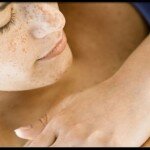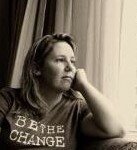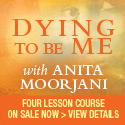by Lisbeth Coiman
I have Dowling Degos Disease, a rare skin condition without known cure. More frequent manifestations of this condition are present in the armpits and the groin. To the common eye, DDD looks like a three day old beard and unshaved armpits. Occasionally, DDD also shows on the face and vulva. On the face, the hyperpigmented web pattern becomes a profusion of black heads around the mouth, nose and chin, along with depressed acne scars – minus the acne.
Twenty-five years ago, a doctor in Venezuela tried an experimental procedure on my face. This is what happened to me, and its consequences.
The doctor explained what they were about to do. They would freeze the skin of my face with helium, and then they’d use a rotary tool to peel the epidermis off of my chin. I felt the anesthesia going in first, and then helium spray and my skin going numb and hard as a piece of wood. Then I heard the rotary tool coming nearer my face, as a dentist drill, its perforating sound penetrating my ears with fear and hesitation. Later, the sensation of something being scraped off of my chin and upper left side, near the temples. They came down again to the chin, found a small tumor and decided to remove it. It was deep, and deeper they went with the rotary tool. The tumor was on the left side of my chin. I could hear them talking in medical jargon, naming the tumor, explaining its structure. In five minutes, it was over.
The nurse used plenty of gauze to soak up the gelatin coming out of the dermis. I didn’t see anything. The nurse said, “After twenty four hours remove the bandages. With the tip of your fingers, peel off the white film that will start growing on the wound. Don’t let scab grow, or it will cause a scar.” She then explained in meticulous detail how to clean the wound, how to replace the bandages.
As directly, twenty-four hours later I took the bandages in front of the mirror and I let out a cry of horror. The lower part of my face was monstrously swollen. The skin below the lower lip was raw meat, the bare dermis out, bleeding a gooey gelatin mess. On the left side of the chin, there was what looked like a hole in the flesh. It was painful to watch and I started crying, no less than I am crying now, as I realized with utter resignation that at 23 I had been scarred for life.
Diligently, I set out to do everything I was supposed to. The pain was excruciating. I wondered what on earth they had done. It was unbearable. I could not remove the white film, as I had been instructed. The wound was deeper than the dermis, untouchable without anesthesia. Oh, I tried, screaming from the pain, but it was impossible.
I went to the doctor next day, and he said there was nothing they could do then. They gave me medication for the pain. Every day I cleaned the rest of the wound until the new skin began to grow, still red as raw meat. I didn’t touch the little corner on the left; I abandoned it to its pain and its infection. Soon the scab began to grow, and later a keloid that would cross it from right to left, bottom to top of that little round spot on the left of my chin.
The new skin came out a tone lighter than my usual tan. The keloid was treated with steroids, which caused a lot more pain, but at least the infection was gone, and I could resume my life without bandages. Darkening of the skin followed, as is common among non-white patients. For the rest of my life, I have to protect my face from the sun, wear sunscreen by the pound, and cover with a hat or umbrella.
I am a weird sight. I wear a hat everywhere I go. In the middle of the summer, while working in the garden, I am covered head to toe. I bathe myself in sunscreen every morning when I get up from bed. My chin looks like a three days old beard. The left side of it is a little sunken, as if a bit of skin had been sliced off of my chin.
I have a peculiar face, noticeable, memorable and unique. It does not need a mouth to tell my story. I can see people elbowing each other as I walk along supermarket aisles. Little kindergarteners have come to me and asked in their little shrieking voices “are you a mom or a dad?” Impertinent people ask me if I am contagious. Employers have been known to reject my applications, because they don’t know what to make of my face.
I lost my youth’s beauty long before I grew old. With the years, I have come to accept my scar as part of my identity, something that defines me without words. If you meet me, you’d probably remember the woman with the funny face.
Lisbeth Coiman is a writer, teacher, translator and married mother of two young men. Coiman has published a small collection of short stories and poems on her page on www.wattpad.com/Cayena. She is working on a book of memoir about female friendship, mental disorders and the healing power of love.













When I met you, what made an impression on my was your funny…humor. I’m so sorry you had to endure such anguish.
I winced as I read the description of the surgery and the healing process. You are an amazing woman, Lisbeth. Thank you for your words.